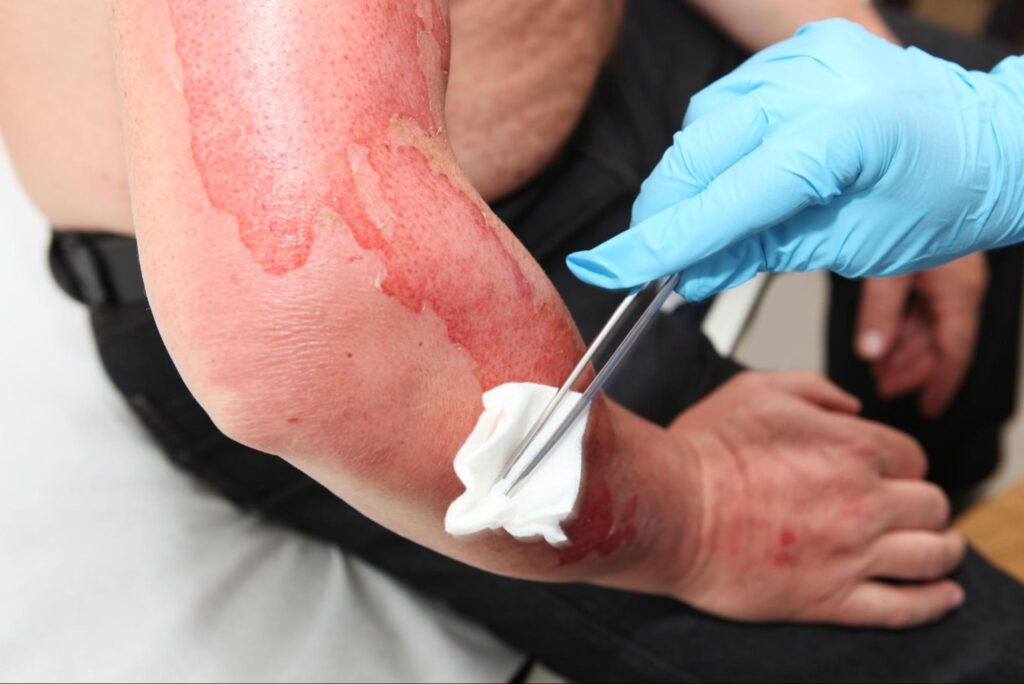Burn Injury Guide

UpToDate reports that approximately one million people seek treatment for burns every year in the United States. While most of these burns are not severe enough to warrant hospitalization, about 450,000 burns are more serious and life-threatening, according to the American Burn Association.
When you or a loved one are seriously burned, the resulting injuries can take a long time to heal. In some cases, you may never fully recover, or worse, complications from your injuries could result in loss of life. Unfortunately, catastrophic burn injuries can cause financial problems, lost wages, excessive medical bills, and ongoing pain and suffering.
In cases where your burn injuries were due to the negligence of another, you may have legal recourse against the responsible party. At Bachus & Schanker Elite Litigation Group, our burn injury attorneys are here for you every step of the way.
Get your free case consultation and assistance filing a burn injury claim. Schedule your appointment with our burn injury lawyers today.
Our free burn injury guide covers everything you need to know about burn injuries and when to file a burn injury claim, including:
- What is a burn injury?
- Types of burn injuries
- What are the most common ways burn injuries happen?
- What should I do if my burn injury happens at work?
- What should I do immediately after experiencing a burn injury?
- How are burn injuries treated?
- Filing a burn injury claim
- Filing a wrongful death claim for burn injuries
What is a burn injury?
The Mayo Clinic defines a burn injury as damage to the skin, tissue, and other parts of the body from exposure to a source of heat, fire, sun, or other electrical, radiative, or chemical contact. The extent of the burn can range from minor injuries to the surface of the skin to deep tissue damage.
The severity of a burn injury depends on what part of the body was burned, the cause of the burn, and the person’s age. For instance, a burn injury on the neck or face could create respiratory problems, vision problems, and other complications. In addition, the elderly and children do not tend to recover as well from serious burn injuries.
Types of burn injuries
The severity of the burn injury is classified into different degrees based on the type, depth, size, and location of the burn as follows:
First-degree Burns
First-degree burns are the least severe and are also called superficial burns. Only the top layer of the skin is burned. The area can appear red with some pain and discomfort. With proper treatment, the damaged skin will heal in several days to a week.
Second-degree Burns
Second-degree burns are slightly more severe and extend down into the dermis layer of the skin. This type of burn is painful, and the pain will remain for quite some time. The skin will usually appear red and swollen, and it can blister. The burned area will heal with proper treatment but can take a few weeks to a month. Minor scarring may also be present after the burn heals.
Third-degree Burns
Third-degree burns are considered more serious and should be treated immediately. The burned area will extend downward into the lower layers of the skin, often burning the entire dermis layer and going deeper into tissues and fatty layers.
In addition, you can experience extreme pain and discomfort from third-degree burns during the injury. However, since nerve endings are also destroyed in the process, you may notice the burned area is numb and has no feeling. These wounds will not heal on their own without medical intervention.
Fourth-degree Burns
Fourth-degree burns are the most severe and life-threatening type of burns. The damage extends past the tissues and fatty layers into muscle, tendons, and bone. Emergency medical treatment is required as there can be life-threatening complications that could result in death. The burned area may never fully heal and will be badly scarred.
What are the most common ways burn injuries happen?
The most common ways people get burned include:
- Fires – Fires are the leading cause of burn injuries.
- Scalding – The second cause of burn injuries is from excessively hot liquids, including boiling water, coffee, scorching hot food, and steam.
- Thermal Burns – Thermal burns are when a burn occurs from direct contact with an extremely hot item, like a cooktop burner, oven rack, curling iron, or iron.
- Electrical Burns – Electrical burns occur when you make contact with a source that sends electricity through the body.
- Chemical Burns – Chemical burns can be caused by corrosive substances and hazardous waste materials that come into contact with different areas of the body.
- Radiation Burns – Overexposure to radiation can cause burning of the skin and damage to internal organs and tissues.
- Inhalation Burns – The lungs and respiratory system can be burned internally from smoke inhalation and inhaling toxic chemical fumes.
- Explosions – Explosions from gas leaks, overpressurized equipment, and other causes can cause serious and deadly burn injuries.
What are some common causes of burn injuries?
- House and business fires.
- Faulty electrical wiring.
- Improper storage of flammable materials.
- Improper usage of flammable materials.
- Defective products.
- Improperly working equipment or machines.
- Automobile and truck accidents.
- Unsafe working conditions.
What should I do if my burn injury happens at work?
If your burn injury happens at work, it is important to follow the correct procedures to protect your right to file an injury claim and ensure you get the proper compensation for your injuries.
- Seek medical treatment for your burn. It is vital to take care of your well-being first and foremost. According to Section 8-41-101 of the Colorado Workers Compensation Act, an “employer must furnish medical aid…contracting for treatment.” Therefore, there is no cost to you to have your burn medically treated.
- Report the burn injury and file an injury report with your employer. It is essential to report the burn injury as soon as possible. There are filing deadlines for worker’s compensation claims you do not want to miss.
- Speak with a burn injury attorney. It costs nothing to consult with a burn injury attorney about your workplace accident. They provide free legal advice and advise you on your next steps in filing your worker’s compensation claim. They can also assist you with filing your burn injury claim.
- File your worker’s compensation claim. Worker’s compensation is available regardless of fault. It covers current and future medical care and treatment costs, out-of-pocket expenses for bandages, ointments, prescriptions, etc., and lost wages.
Even if it seems like you only sustained a minor burn injury, you should still follow these steps.
Sometimes minor burns can worsen, and there could be internal injuries you are unaware of at the time of the accident.
Can I sue my employer for my burn injuries?
In most cases, you cannot sue your employer for your burn injuries. The tradeoff is you get to receive worker’s compensation benefits. However, if you can establish and prove your employer was grossly negligent, then you might be able to sue them.
Furthermore, if workplace burn injuries resulted from a negligent third party, you could sue them for your injuries. For example, you are operating a defective machine. The defect in the machine is the cause of your burn injuries. In this situation, you might have grounds to sue the manufacturer of the defective equipment.
What should I do immediately after experiencing a non-work-related burn injury?
When another’s negligence caused your burn injury, you may have grounds to file a personal injury claim against the responsible party and their insurance company. With personal burn injury claims, you can be entitled to current and future medical expenses, lost wages, and pain and suffering.
What to do after a burn injury for a non-work-related accident is to seek medical treatment just like you would for a workplace burn. If possible, you should document when, where, and how the injury occurred. It can also be helpful to take pictures of the accident scene and gather witnesses’ names and contact details.
However, if you are not physically capable of doing this, your health and well-being are more important. After receiving medical treatment, or if you are still in the hospital, you or a family member should contact a burn injury lawyer for a free consultation.
Personal burn injury claims can be rather complex depending on the severity of the burn, the percentage of the body burned, and attempting to negotiate a fair settlement with the insurance company.
How are burn injuries treated?
The treatment for burn injuries will vary based on the severity of the burn and the location where it occurs on the body.
Minor Burns
Most minor burns are easy to treat at home, except when they occur on the face, neck, or genital region. It is important to wash the burn using cool water and antibacterial soap.
Next, you should apply some type of burn ointment and bandage the burn to protect it from infection. Over the next week or so, remove the bandage, clean the burn, and apply fresh burn ointment and a new bandage until it heals.
Moderate Burns
For second-degree burns, it is recommended to seek medical treatment. While these burns will also heal in a few weeks, you may need special dressings and medications to promote healing and prevent infections.
Severe Burns
Both third-degree and fourth-degree burns require immediate medical treatment. Surgery may be necessary in certain situations. In addition, you may need assistance with breathing, pain relief, and nutritional support.
Once you are stabilized, part of your treatment could require using skin grafts to graft new skin over the burn wound to help it heal. These procedures can result in longer hospital stays. In extreme burn cases, reconstruction surgery may be necessary.
How do I file a burn injury claim?
Whether your burn injury occurred at work or as the result of personal injury caused by another, it is always in your best interest to consult with a worker’s compensation and personal burn injury lawyer. Having a lawyer file your claim ensures it is completed correctly and within the statute of limitations, usually within two years of the burn injury.
Additionally, your lawyer will file the claim against the correct responsible party and their insurance company. The sooner you file, the better it is for your claim and to secure the best settlement. The longer you wait, the more difficult the process can become. If you file after the statute of limitations expires, your claim will be denied.
How do I file a wrongful death claim when my loved one dies from burn injuries?
Filing wrongful death damages from burn injuries when your loved one dies requires assistance from an experienced wrongful death attorney. At Bachus & Schanker Elite Litigation Group, we understand you are already facing an emotionally difficult time. Our goal is to help you and your family navigate the complexities that often arise in wrongful death claims.
While no amount of monetary compensation can make up for the loss of a loved one, we strive to ensure you receive the compensation you deserve. Our Elite Litigation Group provides the comprehensive support and advocacy you require so you can grieve and start rebuilding your life.
Get the help you need to file a burn injury or wrongful death claim by scheduling a free consultation with our burn injury attorneys today.
Sources:
Rice, Jr. M.D., P., et al. (2022). Emergency Care of Moderate and Severe Thermal Burns in Adults.
Asselin, K. (2020). National Burn Awareness Week 2020.
Burns. (2021).
Colorado W.C. Act Section 8-41-101. (2022)
Client Stories
Meet Our Legal Experts
We know what happened to you is unimaginable. Our only goal is to help you and your family on this painful journey and fight for your rights. When you need skilled, experienced, and compassionate representation, the Elite Litigation Group is here for you. With years of experience and multiple office locations serving nationwide, our personal injury attorneys are ready to serve you and fight for the compensation you deserve.
Testimonials
“Thank you for not giving up on me”
…there was a point when I wanted to give up… Bachus & Schanker did not give up on me. They just kept pushing through and letting me know that we’re on a team and that they’re there for me, to support me and help me in any way I need.
Thank you for giving me a second chance, for helping me with a second chance and thank you for not giving up on me.
When you go through an accident, so many people you find give up on you and you don’t matter anymore to them and that wasn’t the case with Bachus & Schanker.
Molly Cain




